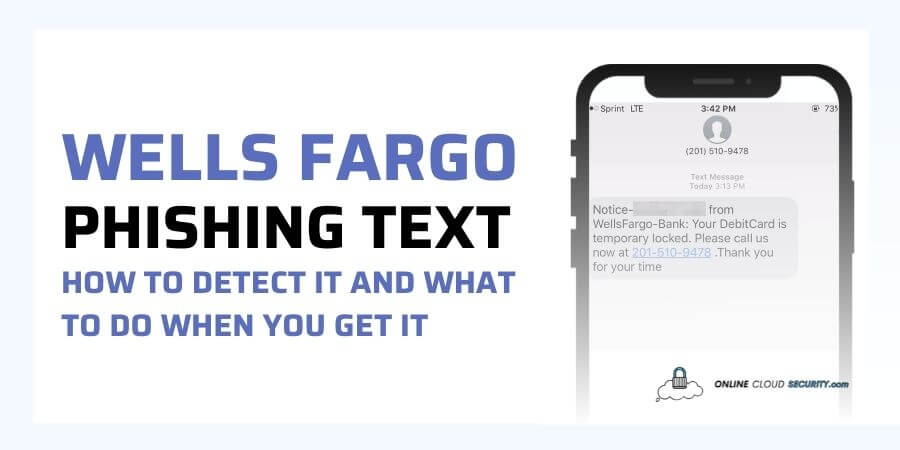
Dave Miller – Tech Enthusiast & Security Expert – June 18th, 2022

You may not need to answer an unusual SMS from Wells Fargo since it might be a Wells Fargo Phishing Text. Scammers use email or text communications to persuade a victim to divulge personal information to the attacker. As a matter of fact, an analysis of more than 55 million emails reveals that one in every 99 emails is a phishing attack.
The issue is that fraudsters frequently adapt their strategies, and it might be hard to understand a targeted assault. However, several telltale signals might help you spot a phishing email or text message. It should be well-known to you to maintain a secure online presence.
Continue reading the article. I will discuss the Well Fargo Phishing Text as well as additional tips for you to keep secure.
Scams involving banks are on the rise. Thousands of people receive SMS daily posing as a bank, and users may lose hundreds, if not thousands, of money due to these SMS texts.
Customers of Well Fargo, one of America’s largest banks, are not immune to similar attacks. Recently, many customers who had Well Fargo accounts, or even if they didn’t, received text messages as Wells Fargo phishing text. The text claimed that their account with the bank got limited or suspended and that they should click the link provided in that message to unlock their access.
It is where you should see red flags, as you should remember not to click on suspicious or unknown senders’ links. Wells Fargo announced on Twitter about such a scam and wrote.
“Did you receive an unexpected text from Wells Fargo? Don’t respond!”
They also included a link to their website detailing how such a scam occurred and how you may stay secure even if you accidentally clicked on the link.
Note: Not only that, but several customers described receiving a phishing email that required them to confirm their identity within 24 hours of receiving the warning. The message threatens that if they don’t, they won’t be able to move or withdraw money from their accounts.
But don’t worry; I’ll explain all you need to know about Wells Fargo phishing text as a summary of what you need to do.
Here’s everything you need to know about phishing attempts, as described by Wells Fragon.
Since many scam text messages targeting Wells Fargo banking clients are circulating in the United States. It would help if you had a broad notion of how to spot these con artists. However, as detailed below, you must first refrain from engaging with this material and erase it as soon as possible.
Fact: Official Wells Fargo short codes are 935-57, 937-33, 937-29, or 937-67.
Note: Everything should come straight from Wells Fargo; the exact requirements apply to email. As a result, you will be responsible for determining the official email address from their website.
Scammers can impersonate a bank employee by doing a background check on you and obtaining information from somewhere on the internet. Because the fraudster employs spoofing technology to alter the number on your caller ID, the call may appear to be from your bank. So, in this scenario, you need to know what a bank will never ask you for, so you may avoid giving your personal information to anyone attempting to exploit technology.
You’re ready to go after you’ve learned how to spot phishing scams. The next step is to report to the Wells Fargo authorities if you’ve been the victim of a similar text, email, or phone scam. You will find yourself in two scenarios below
If you opened an attachment, clicked on a link, or gave personal or account information. The first thing you should do is call Wells Fargo at 1-866-867-5568, and if you reside or are traveling outside of the United States, you may call them toll-free from most countries.
You can also report the scam to the Federal Trade Commission, which will enlist the assistance of law enforcement partners in the investigation. Report the text to 7726 (SPAM) and use your built-in Messages app to block the number.
Note: If 7726 doesn’t work, contact your phone carrier to learn how to report a text message.
If you’re already dubious about the email or text, you received. In that case, you may report it to mailto:reportphish@wellsfargo.com and have it removed simultaneously. Wells Fargo will first send you an automatic answer. Then they will analyze your letter immediately and take appropriate action.
In an emergency, please see the link below for additional contact information.
Apart from the guidelines above, keep in mind the following: the more I discuss these topics with you, the better prepared you will be for any phishing attempt.
In a phishing effort, cybercriminals utilize a well-constructed attack to dupe consumers into handing over sensitive information. But believe me when I say this isn’t a new issue; the world has been dealing with it for some time. Even though, in the mid-1990s, the only Internet options were either a fee-based dial-up connection or an AOL floppy disk. That was the time when phishing emerged as a cyber threat.
A gang of hackers known as the warez community pretended to be AOL employees. This gang employed algorithms to generate randomized credit card numbers using login passwords and personal information obtained from AOL. It was members of this community that were the first to launch phishing assaults.
Over the years, due to the financial rewards of these assaults, phishing has become a viable industry for hackers, with around 156 million hoax emails getting generated daily, resulting in over 80,000 clicks!
Wells Fargo & Company is a global financial services corporation based in the United States. It got established in 1852 in San Francisco. It offers banking, investing, mortgage goods & services, and consumer and business finance through more than 7,200 branches and 13,000 ATMs.
The Financial Stability Board classifies the corporation as a systemically significant financial institution since it operates in 35 countries and serves over 70 million clients worldwide.
Here are a few recent phishing situations in which attackers successfully exploited the users’ lack of awareness or understanding.
To authenticate each transaction, Alyssa Beckwith signed up for SMS notifications from her bank, Wells Fargo. So when she received a text message from a fraudster claiming that her Wells Fargo card had got debited with a $240 transaction, she didn’t hesitate to phone and check herself.
She typed her credit card information, Social Security number, and birthdate into a robotic voice that greeted her at Wells Fargo and requested her to authenticate herself. That information may now get used to committing various crimes, such as stealing cash or creating debit cards in their name.
Phishing scams are not limited to individuals as even big companies can fall victim. An extensive phishing effort defrauded Facebook and Google of $100 million. Since then, both organizations have relied on Quanta, a Taiwanese firm, as a provider. To acquire money from both, the attacker created bogus invoices. Even though the assailant was apprehended, Facebook and Google would only recoup $49.7 million through legal action.
A hacking team known as Fancy Bear attacked John Podesta’s Gmail account. Phishers posing as Google sent him an email stating that he needed to be changed his email address due to an attempted breach. Thousands more emails were leaked via WikiLeaks in the days before the election, causing a lot of controversy in the weeks running up to the election.
Compared to the yearly average, phishing incidents increased by 220 % during the peak of the worldwide epidemic. Here are the latest phishing attempts from across the world.
Cyberattacks are real, and no one is entirely secure from them, as they are sometimes unavoidable. Today, I discussed different phishing attacks and how they might affect you. I’ve also included instructions on dealing with Wells Fargo Phishing Text. The next thing you should do is educate yourself on safe internet behaviors since this may be the only way to keep yourself safe. You may also install trustworthy security solutions that protect your data from fraudsters and alerts you about scams and phishing attempts.
You may now report this latest fraud, as well as any others that officials should be aware of, to the Federal Trade Commission and Wells Fargo, as outlined in this post.
**Onlinecloudsecurity.com is a participant in the Amazon Services LLC Associates Program, an affiliate advertising program designed to provide a way for websites to earn advertising revenues by advertising and linking to Amazon.com and affiliated sites. As an Amazon Associate we earn affiliate commissions from qualifying purchases.**

Dave Miller is an IT Consultant for Online Cloud Security and has over 7 years of experience in the Information Technology space. He also specializes in repairing laptops & computers. In his spare time, he loves to talk about new technologies and hosts monthly IT and Cyber Security meetings in the Houston area.
Click any button down below to share this article on the following channels:

Online Cloud Security is here to recommend you the most secure devices, from laptops to smartphones, we only want to provide you with products that we have tested and used ourselves for online security. Every product that we recommend is heavily inspected and tested for security against hackers, viruses, malware, and any other intruders that may want to steal your information.

Online Cloud Security is here to recommend you the most secure devices, from laptops to smartphones, we only want to provide you with products that we have tested and used ourselves for online security. Every product that we recommend is heavily inspected and tested for security against hackers, viruses, malware, and any other intruders that may want to steal your information.
Your Trusted Source for Online Security